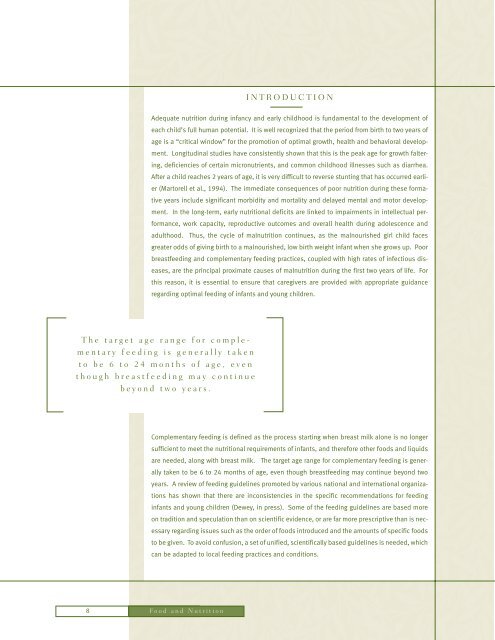Guiding Principles for Complementary Feeding of the Breastfed
Guiding Principles for Complementary Feeding of the Breastfed
Guiding Principles for Complementary Feeding of the Breastfed
Create successful ePaper yourself
Turn your PDF publications into a flip-book with our unique Google optimized e-Paper software.
INTRODUCTION<br />
Adequate nutrition during infancy and early childhood is fundamental to <strong>the</strong> development <strong>of</strong><br />
each child’s full human potential. It is well recognized that <strong>the</strong> period from birth to two years <strong>of</strong><br />
age is a “critical window” <strong>for</strong> <strong>the</strong> promotion <strong>of</strong> optimal growth, health and behavioral development.<br />
Longitudinal studies have consistently shown that this is <strong>the</strong> peak age <strong>for</strong> growth faltering,<br />
deficiencies <strong>of</strong> certain micronutrients, and common childhood illnesses such as diarrhea.<br />
After a child reaches 2 years <strong>of</strong> age, it is very difficult to reverse stunting that has occurred earlier<br />
(Martorell et al., 1994). The immediate consequences <strong>of</strong> poor nutrition during <strong>the</strong>se <strong>for</strong>mative<br />
years include significant morbidity and mortality and delayed mental and motor development.<br />
In <strong>the</strong> long-term, early nutritional deficits are linked to impairments in intellectual per<strong>for</strong>mance,<br />
work capacity, reproductive outcomes and overall health during adolescence and<br />
adulthood. Thus, <strong>the</strong> cycle <strong>of</strong> malnutrition continues, as <strong>the</strong> malnourished girl child faces<br />
greater odds <strong>of</strong> giving birth to a malnourished, low birth weight infant when she grows up. Poor<br />
breastfeeding and complementary feeding practices, coupled with high rates <strong>of</strong> infectious diseases,<br />
are <strong>the</strong> principal proximate causes <strong>of</strong> malnutrition during <strong>the</strong> first two years <strong>of</strong> life. For<br />
this reason, it is essential to ensure that caregivers are provided with appropriate guidance<br />
regarding optimal feeding <strong>of</strong> infants and young children.<br />
The target age range <strong>for</strong> complementary<br />
feeding is generally taken<br />
to be 6 to 24 months <strong>of</strong> age, even<br />
though breastfeeding may continue<br />
beyond two years.<br />
<strong>Complementary</strong> feeding is defined as <strong>the</strong> process starting when breast milk alone is no longer<br />
sufficient to meet <strong>the</strong> nutritional requirements <strong>of</strong> infants, and <strong>the</strong>re<strong>for</strong>e o<strong>the</strong>r foods and liquids<br />
are needed, along with breast milk. The target age range <strong>for</strong> complementary feeding is generally<br />
taken to be 6 to 24 months <strong>of</strong> age, even though breastfeeding may continue beyond two<br />
years. A review <strong>of</strong> feeding guidelines promoted by various national and international organizations<br />
has shown that <strong>the</strong>re are inconsistencies in <strong>the</strong> specific recommendations <strong>for</strong> feeding<br />
infants and young children (Dewey, in press). Some <strong>of</strong> <strong>the</strong> feeding guidelines are based more<br />
on tradition and speculation than on scientific evidence, or are far more prescriptive than is necessary<br />
regarding issues such as <strong>the</strong> order <strong>of</strong> foods introduced and <strong>the</strong> amounts <strong>of</strong> specific foods<br />
to be given. To avoid confusion, a set <strong>of</strong> unified, scientifically based guidelines is needed, which<br />
can be adapted to local feeding practices and conditions.<br />
8 Food and Nutrition

















